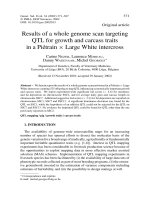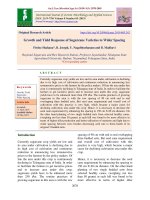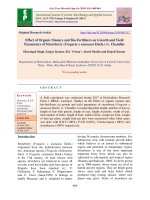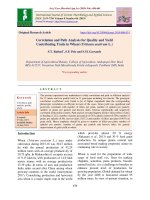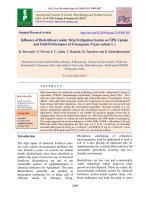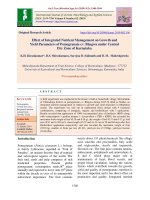Genetic analysis for growth and yield traits of different Genotypes of Pea (Pisum sativum L.) under prayagraj agro-climatic condition
Bạn đang xem bản rút gọn của tài liệu. Xem và tải ngay bản đầy đủ của tài liệu tại đây (369.27 KB, 9 trang )
Int.J.Curr.Microbiol.App.Sci (2020) 9(3): 797-805
International Journal of Current Microbiology and Applied Sciences
ISSN: 2319-7706 Volume 9 Number 3 (2020)
Journal homepage:
Original Research Article
/>
Genetic Analysis for Growth and Yield Traits of Different Genotypes
of Pea (Pisum sativum L.) under Prayagraj agro-climatic Condition
Jai Vardhan Raj*, V. M. Prasad, Vijay Bahadur, Rajneesh Srivastava and Devi Singh
Department of Horticulture Sam Hinggin Bottom University of Agriculture, Technology and
Sciences, Prayagraj, India
*Corresponding author
ABSTRACT
Keywords
Genetic variability,
Heritability,
Genetic advance,
and pod yield
Article Info
Accepted:
05 February 2020
Available Online:
10 March 2020
The present investigation was conducted during Rabi seasons of 2014-15 and
2015-16 at the experimental field of Department of Horticulture, Prayagraj School
of Agriculture, Sam Higginbottom University of Agriculture Technology and
Sciences, Prayagraj The analysis of variance revealed that mean squares due to
genotypes were significant for all the characters during both the years which
indicated that, considerable genetic variation among the genotypes for all the
traits. The genotypes viz., VRP-22, VRP-5, KS-156, Azad Pea and VRP-7 were
found promising for growth characters during both the years. The genotypes
namely, KS-156, VRP-22, Azad Pea-3, VRP-5 and KS-149 were found superior
for pod yield and its attributes. The estimates of PCV were higher than
corresponding GCV for all characters studied which indicated that the apparent
variation is not only due to genotypes but, also due to the influence of
environment. High heritability coupled with high genetic advance were observed
for pod yield per plant, height of plants, number of branches per plant, number of
pods per plant, protein and ash content during both the years which revealed that
these characters are governed by additive gene action and phenotypic selection
would be effective for the improvement of characters.
uses. India ranks third in area after China and
USSR under pea (vegetable and pulse pea)
cultivation. In India, the total area covered by
pea is 0.46 million hectare with the
production of 4.24 million tonnes whereas,
productivity is 9.5 tonne per hectare. It is
grown extensively in Uttar Pradesh, Madhya
Pradesh, Himachal Pradesh, Punjab, Haryana,
Introduction
Garden pea [Pisum sativum L. var. hortense,
2n=2x=14], is an important vegetable belongs
to the family Fabaceae. It is harvested in
immature stage for table purpose and to be
cooked as green peas to provide a delicious
dish, or to be canned or frozen for subsequent
797
Int.J.Curr.Microbiol.App.Sci (2020) 9(3): 797-805
Rajasthan, Maharashtra, Bihar and Karnataka,
contributing to 67% of the total production
(Anonymous, 2016).
of Agriculture, Sam Higginbottom University
of Agriculture Technology and Sciences,
Prayagraj. The experimental material for the
present investigation comprised twenty
genotypes of garden pea collected from
different places in India and being maintained
at Department of Horticulture, Prayagraj
School of Agriculture, Sam Higginbottom
University of Agriculture Technology and
Sciences, Prayagraj (U.P.) Table-1.
Evaluation of germplasm is the basic tool for
identification of important genotypes. The
great extent of natural variation available for
various characters among the genotypes
suggests good scope for improvement in
economic traits. Large variability ensures
better chance of producing new forms.
Variability parameters like genotypic and
phenotypic
coefficient
of
variations,
heritability and genetic advance, is of
paramount significance in formulating an
appropriate breeding strategy aimed at
exploiting the inherent variability of the
original population. Phenotypic variability
changes under different environmental
conditions, while genetic variability remains
unchanged and more useful to a plant breeder
for exploitation in selection or hybridization.
The correlation studies provide information
about association between any two characters.
Knowledge of correlation among different
traits and further portioning them into direct
and indirect effects is one of approaches to
understand nature and extent of such
relationship. Currently the pea production per
unit area is low as compare to china, the many
reason for low productivity in India is use of
local varieties and traditional cultivation
methods followed by the farmers. To increase
the productivity of garden pea and look out
the effect of most survival varieties under
Prayagraj agro-climatic condition.
The experiments were laid out in Randomized
Block Design with 20 treatments replicated
thrice. The observations were recorded on
characters viz., height of plants (cm), number
of branches per plant, pod width (cm),
number of pods per plant, pod length (cm),
number of grains per pod, number of nodes
per plant, pod yield (t/ha), on five randomly
selected plants during both the yeas. The
observations recorded on the five plants were
summed up and divided by five to get mean
value. The experimental data was compiled
by taking the mean value of the twenty
genotypes of pea garden for eight yield and its
components traits from all the three
replications. Then it was subjected to the
statistical analyses to the procedure outlined
by Panse and Sukhatme (1967).
Results and Discussion
The continuous variation exhibited by
quantitative traits with which the breeders
have to deal with, include the heritable and
non-heritable components. Though, it is
difficult to assess the genotype directly but it
is possible through the assessment of
phenotypic expression (which is an outcome
of interplay of the genotype and environment)
in the existing material and thus, the study of
phenotypic variability for yield and its
component traits is very important.
Materials and Methods
The investigation entitled “Genetic Analysis
for qualitative and quantitative traits of
different genotypes of pea (Pisum sativum L.)
under Prayagraj agro-climatic condition” was
conducted during Rabi seasons of 2014-15
and 2015-16 at the experimental field of
Department of Horticulture, Prayagraj School
The analysis of variance (Table 2) revealed
that mean squares due to genotypes were
798
Int.J.Curr.Microbiol.App.Sci (2020) 9(3): 797-805
significant for the traits viz., height of plants
(cm), number of branches per plant, pod
width (cm), number of pods per plant, pod
length (cm), number of grains per pod,
number of nodes per plant, pod yield (t/ha),
T.S.S, protein (%), ascorbic acid (mg/ 100g),
ash content (%) and moisture (%) which
indicated that considerable genetic variation
among the genotypes for all the traits.
Sufficient genetic variability for many traits
has also been reported by earlier workers viz.,
Kumar et al., (2010), Sharma et al., (2011)
and Katoch et al., (2015) thereby, supporting
the present findings.
14.64 to 23.18, and 22.02 with mean 19.39.
18.42 In Y1 and Y2, respectively. The
maximum number of nodes per plant were
recorded in genotype VRP-22 (23.18)
followed by VRP-5 (22.47), Azad Pea-4
(21.26), KS-156 (20.83) and VRP-7 (20.40)
in Y1 and in Y2 KS-156 (22.02) followed by
Azad Pea-3 (21.17), Azad Pea-4 (20.19),
PRP-801 (20.10) and Azad Pea-2 (19.38).The
present findings are in accordance of earlier
research workers viz., Ramesh and Tewata
(2002) and Arya et al., (2004).
The number of pods per plant directly
influenced the yield potential of a genotype.
A wide range of genetic variability existed for
this character among the genotypes under
study. In Y1 (Table-3), maximum number of
pods per plant were produced by VRP-22
(29.13) followed by VRP-7 (26.13), Azad
Pea-4 (23.69), VRP-5 (23.69) and Vivek
Mater (23.19). Minimum number of pods per
plant were recorded in PMR-71 (12.43)
followed by KS-501 (13.69). Nine genotypes
produced significantly higher number of pods
than check (Arkel). The pods per plant varied
from 12.43 to 29.13 with grand mean 19.77.
Similarly in Y2, maximum number of pods
per plant were produced by KS-156 (27.67)
followed by VRP-7 (24.82), Azad Pea-3
(24.00), Azad Pea-4 (22.87) and Vivek Mater
(22.04). Minimum number of pods per plant
were recorded in KS-501 (13.15) followed by
PMR-71 (13.97). Eight genotypes produced
significantly higher number of pods than
check (Arkel). The pods per plant varied from
13.15 to 27.67 with grand mean 19.11.
Genetic variability for this character has also
been observed by Singh and Singh (2011).
In Y1 (2014-15) perusal of table 2 revealed
that three genotypes viz., VRP-22(106.33 cm),
KS-156 (94.00 cm) and VRP-5 (96.33 cm)
were significantly superior to check (Arkel).
The genotypes exhibited an average plant
height of 79.47 cm with a range of 40.67 cm
to 106.33 cm. Similarly, In Y2 (2015-16) The
genotypes exhibited an average plant height
of 75.38 cm with a range of 39.24 cm to
101.02 cm and only one genotype KS-156
(101.02 cm) was significantly superior to
check (Arkel). Higher pod yield in taller
plants could be attributed due to production of
more number of pods per plant. The findings
are in accordance with earlier researchers
(Alam et al., 2010 and Khan et al., 2013).
The number of branches per plant varied from
7.25 (PMR-71) to 14.57 (VRP-22) and with
overall mean 12.28 and 6.81 (PMR-71) to
14.18 (KS-156) with grand mean 11.58
branches per plant In Y1 and Y2, respectively.
The genotypes namely VRP-22 and KS-156
produced high number of branches per plant
during both the years. The more number of
branches could be attributed to increasing
number of pods per plant which lead to higher
pod production. The genotypes showed
significance differences among the also
reported by Gupta and Singh (2007). The
number of nodes per plant ranged from 15.54,
The mean values of genotypes (Table-3)
revealed that in Y1, and Y2 genotype E-6 had
the maximum pod length 9.77 and 9.27 cm,
respectively, The pod length varied from 7.98
cm to 9.77 cm cm.and7.57 cm to 9.27 cm
with general mean 8.93 and 8.46 cm in Y1 and
799
Int.J.Curr.Microbiol.App.Sci (2020) 9(3): 797-805
Y2, respectively. Genetic variability for this
character has also been observed by Pani et
al., (2001), Habib and Zamin (2003) and
Kalloo et al., (2005).
genotype KS-156 (15.66 t/ha, 14.76 t/ha)
followed by VRP-22 (15.03 t/ha,14.28 t/ha),
Azad Pea-3 (14.14 t/ha, 13.43 t/ha), Minimum
pod yield was recorded in PMR-71 (3.99 t/ha,
3.85 t/ha) , respectively. Eleven genotypes
found significantly superior to check (Arkel).
The green pod yield t/ha varied from 3.99 to
15.66 with overall mean 10.03 t/ha. In Y1 and
in Y2 the pod yield (t/ha) varied from 3.85 to
14.76 with grand mean 9.54. These results are
in agreement with the findings of earlier
research workers viz., Murtaza et al., (2007);
Sharma et al., (2010) and Chadha et al.,
(2013).
The mean values of genotypes (Table-3)
revealed that in Y1, genotype Azad Pea-1 had
the maximum pod width (1.69 cm) followed
by KS-205 (1.65 cm), Azad Pea-1 (1.57 cm),
Vivek Mater-10 (1.53 cm) and VRP-6 (1.46
cm). The minimum pod width was recorded
in Arkel (1.12 cm) followed by E-6 (1.15 cm)
KS-156 and KS-501 (1.28 cm). The pod
width varied from 1.12 cm to 1.69 cm with
general mean 1.39 cm.
Components of variability
In Y2, the maximum pod width was observed
in genotype Azad Pea-1 (1.61 cm) followed
by KS-205 (1.54 cm), KS-149 (1.48 cm),
Vivek Mater-10 (1.46 cm) and VRP-6 (1.38
cm). The minimum pod width was recorded
in VRP-7 (1.05 cm) followed by E-6 (1.09
cm) and KS-501 (1.20 cm). The pod width
varied from 1.05 cm to 1.61 cm with general
mean 1.33 cm.
Various parameters of variability have been
calculated from the data viz., coefficient of
variation at phenotypic (PCV) and genotypic
(GCV) levels along with heritability (h2) in
broad sense and genetic advance (GA) as per
cent of mean for different characters. To
ascertain the nature and magnitude of
observed variability in the hybrids, it was
partitioned into phenotypic, genotypic and
environmental components. The knowledge
of phenotypic coefficient of variation (PCV)
and genotypic coefficient of variation (GCV)
is helpful in predicting the amount of
variation present in the given genetic stock,
which in turn helps in formulating an efficient
breeding programme. The estimates of PCV
were higher than corresponding GCV for all
characters studied which indicated that the
apparent variation is not only due to
genotypes but, also due to the influence of
environment.
Number of grains per pod and number of pods
directly influence the yield potential of a
genotype. A wide range of genetic variability
existed for this character among the
genotypes under investigation. In Y1 the pods
per plant varied from 6.13 to 8.51 with grand
mean 7.33.None of the genotypes produced
significantly higher number of seeds per pod
than check (Arkel). whereas, In Y2 Two
genotypes (E-6 and KS-501) produced
significantly higher number of seeds per pod
than standard check (Arkel). The number of
seeds per pod varied from 6.13 to 8.51 with
grand mean 7.32. Genetic variability for this
character has also been observed by Murtaza
et al., (2007); Singh and Singh (2011) and
Singh et al., (2012).
In Y1, the high estimates of phenotypic as
well as genotypic coefficient of variation
were observed for pod yield (35.34 and 34.92
%), number of pods per plant (23.43 and
23.19 %) and height of plants (20.86 and
20.49 %). Whereas, high estimates of PCV
(20.09%) observed in ash content. Moderate
In Y1 perusal of results in Table-3 revealed
that maximum pod yield was produced by
800
Int.J.Curr.Microbiol.App.Sci (2020) 9(3): 797-805
PCV and GCV values were obtained for
protein (18.91 and 18.44 %) and number of
branches per plant (15.26 and 15.10 %).
While, the only moderate estimates of PCV
were observed for number of grains per pod
(12.49 %), T.S.S. (12.15 %), pod width (12.08
%), number of nodes per plant (10.72 %) and
ash content had high estimates of GCV (18.85
%) only. However, the rest of the characters
showed low estimates of PCV and GCV.
%), number of pods per plant (22.04 and
21.65 %) and height of plants (20.66 and
20.26 %). Whereas, high estimates of PCV
(20.16) showed by ash content only.
Moderate PCV and GCV values were
observed for protein (18.65 and 18.39 %) and
number of branches per plant (16.25 and
16.13 %). While, the only moderate estimates
of PCV were observed for T.S.S. (12.09 %),
pod width (11.32 %), number of grains per
pod (10.63 %) and number of nodes per plant
(10.63 %). However, the rest of the characters
showed low estimates of PCV and GCV.
In Y2, the high estimates of phenotypic as
well as genotypic coefficient of variation
were observed for pod yield (35.39 and 34.97
Table.1 List of garden pea genotypes used for the study and their source of origin
S. N.
Name of
Source of origin
genotypes
S.
Name of
N.
genotypes
Source of origin
1
Vivek Mater-10
VPKAS, Uttarakhand
11
PRP-801
ICAR-IIVR, Varanasi
2
E-6
PAU, Ludhiana
12
KS-205
ICAR-IIVR, Varanasi
3
Azad Pea-1
C.S.A. U A & T. Kanpur
13
KS-501
ICAR-IIVR, Varanasi
4
Azad Pea-2
C.S.A. U A & T. Kanpur
14
KS-156
ICAR-IIVR, Varanasi
5
Azad Pea-3
C.S.A. U A & T. Kanpur
15
KS-210
ICAR-IIVR, Varanasi
6
Arkel
IARI, New Delhi
16
VRP-6
ICAR-IIVR, Varanasi
7
Azad Pea-4
C.S.A. U A & T. Kanpur
17
VRP-5
ICAR-IIVR, Varanasi
8
PBP-4
PAU, Ludhiana
18
VRP-7
ICAR-IIVR, Varanasi
9
KS-149
ICAR-IIVR, Varanasi
19
VRP-9
ICAR-IIVR, Varanasi
10
PMR-71
ICAR-IIVR, Varanasi
20
VRP-22
ICAR-IIVR, Varanasi
Table.2 Analysis of variance (mean sum of squares) for eight characters in vegetable pea under
Prayagraj agro-climatic condition during Rabi season, 2014-15 (Y1) and 2015-16 (Y2)
Characters
Source of
Variations
Replication
Treatments
df
Year Height of No. of
Pod
N0. of
plant (cm) branches width pods /
/ plant
(cm)
plant
5.13
0.16
0.00
0.78
2
Y1
7.06
0.08
0.01
0.05
Y2
804.83**
10.39**
0.06**
63.52**
19 Y1
709.08**
10.52**
0.05*
51.98*
Y2
*
38
801
No. of
grains
/ pod
No. of
nodes /
plant
Pod
Yield
(t/ha)
0.05
0.12
1.05**
0.84**
0.12
0.09
1.47**
1.47**
1.28
1.17
11.14**
9.87**
0.63
0.57
37.14**
33.63**
0.04
0.15
0.52
0.23
0.90
0.82
0.30
0.27
*
9.71
0.07
0.01
0.43
Y1
9.29
0.05
0.01
0.61
Y2
*, ** - Significant at 5 % and 1 % probability level, respectively.
Error
Pod
length
(cm)
Int.J.Curr.Microbiol.App.Sci (2020) 9(3): 797-805
Table.3 Mean performance of twenty genotypes for eight characters in vegetable pea under
Prayagraj agro-climatic condition during Rabi season, 2014-15 (Y1) and 2015-16 (Y2)
Characters
Height of plantNo. of
Pod width
Number of Pod length No. of
N0. of nodes Pod Yield
Genotypes
(cm)
(cm)
pods / plant (cm)
per /
branches
grains /
/ plant
(t/ha)
pod
Y1
Y2
Y1
Y2
Y1
Y2
Y1
Y2
V. Mater-10
69.17
65.71
9.85
11.78
1.53
1.46
23.19
E-6
79.60
75.62
12.40
11.78
1.15
1.09
Azad Pea-1
51.10
48.54
8.45
7.68
1.69
Azad Pea-2
89.67
85.56
13.19
12.67
Azad Pea-3
92.00
88.57
13.33
VRP-22
106.33
87.40
Azad Pea-4
87.67
PBP-4
Y2
Y1
Y2
Y1
Y2
Y1
Y2
22.04 7.98
7.58
7.16
7.12
19.33
18.37
7.17
7.83
23.13
13.59 9.77
9.27
8.26
8.26
20.04
19.04
12.49
11.87
1.61
14.83
14.18 9.20
8.74
6.73
6.73
18.62
17.69
5.08
4.82
1.57
1.37
19.96
18.12 8.04
8.27
6.45
7.66
17.41
19.38
7.29
6.81
12.68
1.35
1.28
14.93
24.00 8.55
7.98
6.13
8.04
19.61
21.17
14.14
13.43
14.57
12.67
1.43
1.30
29.13
19.76 9.54
8.24
7.86
6.13
23.18
18.64
15.03
14.28
83.28
12.40
13.11
1.36
1.29
25.26
22.87 8.30
7.89
7.06
7.06
21.26
20.19
11.28
10.72
67.67
64.28
13.26
9.89
1.44
1.37
19.08
18.07 9.67
9.19
6.93
6.93
18.62
17.69
8.24
4.96
KS-149
81.00
84.48
13.33
11.67
1.35
1.48
22.23
16.55 8.50
7.57
6.59
6.45
20.30
19.15
12.93
6.09
PMR-71
40.67
39.24
7.25
6.81
1.33
1.29
12.43
13.97 8.80
8.50
6.19
6.19
19.12
15.14
3.99
3.85
PRP-801
87.33
84.28
13.46
12.99
1.32
1.27
20.79
21.97 8.22
7.91
6.84
6.84
20.33
20.10
12.36
11.93
KS-205
74.67
72.05
12.33
12.73
1.65
1.54
15.76
19.30 8.97
8.66
8.11
8.11
17.48
16.87
8.24
7.95
KS-501
55.00
53.08
10.76
9.38
1.28
1.20
13.63
13.15 9.24
8.91
8.51
8.51
15.69
14.64
6.47
11.48
KS-156
94.00
101.02 13.46
14.18
1.28
1.37
14.93
27.67 8.47
9.06
8.04
7.86
20.83
22.02
15.66
14.76
KS-210
70.75
65.14
12.27
11.94
1.37
1.30
16.09
15.17 8.49
8.01
7.77
7.77
19.76
17.81
5.27
6.87
VRP-6
85.67
80.71
12.67
11.62
1.46
1.38
21.89
21.26 9.50
8.95
7.37
7.37
18.90
18.62
9.38
11.45
VRP-5
96.33
77.92
14.04
10.68
1.35
1.30
23.69
14.85 9.53
8.82
7.34
7.59
22.47
16.40
13.13
12.67
VRP-7
90.07
82.91
13.79
11.40
1.44
1.05
26.13
24.82 8.70
8.65
7.66
7.92
20.40
17.81
12.04
7.83
VRP-9
82.70
76.95
12.33
12.66
1.38
1.31
18.73
21.11 9.36
8.08
7.59
6.59
15.54
18.45
12.18
12.29
Arkel (Check)
88.00
90.77
12.40
13.23
1.12
1.27
19.66
19.75 9.69
8.89
7.92
7.34
18.90
19.28
8.31
8.84
Mean
79.47
75.38
12.28
11.58
1.39
1.33
19.77
19.11 8.93
8.46
7.33
7.32
19.39
18.42
10.03
9.54
C.V. %
3.92
4.04
2.18
1.96
7.51
6.41
3.31
4.10
2.25
4.60
9.87
6.54
4.90
4.90
5.42
5.41
S.E.m ±
1.80
1.76
0.15
0.13
0.06
0.05
0.38
0.45
0.12
0.22
0.42
0.28
0.55
0.52
0.31
0.30
C.D. at 5%
5.15
5.04
0.44
0.37
0.17
0.14
1.08
1.29
0.33
0.64
1.19
0.79
1.57
1.49
0.90
0.85
39.24
7.25
6.81
1.12
1.05
12.43
13.15 7.98
7.57
6.13
6.13
15.54
14.64
3.99
3.85
Highest 106.33 101.02 14.57 14.18 1.69
1.61
29.13
27.67 9.77
9.27
8.51
8.51
23.18
22.02
15.66
14.76
Range
Lowest 40.67
802
Y1
Int.J.Curr.Microbiol.App.Sci (2020) 9(3): 797-805
Table.4.3 Estimates of range, grand mean, phenotypic (PCV), genotypic (GCV), and
environmental (ECV) coefficient of variation, heritability in broad sense, genetic advance (Ga)
and genetic advance in per cent of mean for eight characters in vegetable pea
Characters
Components
Year
Height
of plant
(cm)
No. of
branches
/ plant
Pod
width
(cm)
Number
of pods
/ plant
Pod
length
(cm)
No. of
grains /
pod
N0. of
nodes
per
/plant
Pod
Yield
(t/ha)
Y1
20.86
15.26
12.08
23.43
6.87
12.49
10.72
35.34
Y2
20.66
16.25
11.32
22.04
7.29
10.94
10.63
35.39
Y1
20.49
15.10
9.46
23.19
6.49
7.65
9.53
34.92
Y2
20.26
16.13
9.33
21.65
5.66
8.77
9.43
34.97
Heritability (%)
Y1
96.47
97.96
61.35
98.00
89.24
37.56
79.06
97.65
in broad sense
Y2
96.17
98.55
67.96
96.55
60.26
64.27
78.70
97.66
Genetic advance
Y1
32.94
3.78
0.21
9.35
1.13
0.71
3.38
7.13
Y2
30.85
3.82
0.21
8.38
0.77
1.06
3.17
6.79
Genetic advance
Y1
41.45
30.79
15.26
47.30
12.64
9.66
17.45
71.09
in per cent of
Y2
40.93
32.99
15.85
43.83
9.05
14.49
17.23
71.19
PCV
GCV
mean
*, **: Significant at 5 % and 1 % probability level, respectively.
The high estimates of PCV and GCV for pod
yield, number of pods per plant and height of
plant suggest substantial variability for the
traits thereby ensuring ample scope for
improvement of these traits through selection
Chaudhary et al., (2010) and Kumar et al.,
(2010) have also reported high GCV and PCV
for these characters.
Heritability and genetic advance
The coefficient of variation alone cannot be
803
Int.J.Curr.Microbiol.App.Sci (2020) 9(3): 797-805
used for partitioning the components of
variation (Burton 1952). Heritability in broad
sense is of significance to the breeders as its
magnitude indicates the reliability with which
a genotype can be recognized by its
phenotypic expression. Therefore, genetic
coefficient of variation together with
heritability estimates would give the
appropriate prediction of the amount of
advance to be expected from selection.
differences for the trait among the genotypes
were real. Therefore, selection for these traits
on the basis of phenotypic expression could
be relied upon. Gupta et al., (2006), Kumar et
al., (2013) and Sharma et al., (2013) have
also reported high heritability and genetic
advance for growth and yield traits which
corroborate the present findings.
Finally it may be concluded that KS-156
produced significantly higher pod yield,
during both the years. The wide range of
genetic variation was observed for all the
characters among the genotypes. The
characters like pod yield per plant, height of
plants, number of branches per plant, number
of pods per plant, protein and ash content are
governed by additive gene action and
phenotypic selection would be effective for
the improvement of characters.
High estimates of heritability were (Table-4)
observed for height of plant (96.47 and 96.17
%), number of branches per plant (97.96 and
98.55 %), number of pods per plant (98.00
and 96.55 %), pod yield (97.65 and 97.66 %),
protein (95.03 and 97.23 %), ascorbic acid
(95.03 and 94.97 %), ash content (88.08 and
88.15 %) and moisture (80.47 and 80.52 %)
during both the years, respectively. While,
high estimates of heritability showed in pod
length (89.24%) in Y1 only. Heritability
estimates were moderate for number of nodes
per plant (79.06 and 78.70 %), and pod width
(61.35 and 67.96 %) during both the years (Y1
and Y2), respectively. Whereas, moderate
estimates of heritability (64.27 %) showed in
number of grains per pod in Y2. The low
estimates of low heritability obtained for
number of grains per pod (37.56 %) in Y1.
References
Alam, M. K.; Uddin, M. M.; Ahmed, M.;
Latif M. A. and Rahman M. M. (2010)
Growth and green pod yield of garden
pea varieties under different nutrient
levels. J. Agrofor. Environ. 4 (1): 105107.
Anonymous (2016). Horticulture Data base,
National Horticulture Board, Gurgaon,
Haryana, India.
Burton, G. W. (1952). Quantitative
inheritance in grasses, Proc. 6th INT.
Grassld. Congr. 1: 277-283.
Chadha, S.; Rameshwar; Saini, J.P. and
Sharma, S (2013), Performance of
Different Varieties of Pea (Pisum
sativum L.) under Organic Farming
Conditions
in
Mid
Himalayas.
International J. Agric. and Food Sci.
Tech., 4(7): 733-738.
Chadha, S.; Sharma, R.; Chaudhary, D. R.
and Vidyasagar (2008). Genetic
variability studies in summer pea under
cold desert areas of North-Western
High heritability coupled with high genetic
advance were observed for pod yield per
plant, height of plants, number of branches
per plant, number of pods per plant, protein
and ash content during both the years which
revealed that these characters are governed by
additive gene action and phenotypic selection
would be effective for the improvement of
characters. Moderate heritability along with
moderate genetic advance was observed for
pod width and number nodes per pod.
Presence of high heritability for above
mentioned traits indicated that large
proportion of phenotypic variance was
attributable to the genotypic variance and the
804
Int.J.Curr.Microbiol.App.Sci (2020) 9(3): 797-805
Himalayas. Agrl. Sci. Digest. 28 (1):1013.
Choudhary, H.; Verma, M. K. and Sofi, A. A.
(2010). Genetic variability, heritability
and genetic advance for yield
components in garden pea. Pant. J. Res.
8 (2): 195-197.
Gupta, A. J. and Singh, Y. V. (2007).
Evaluation of garden pea (Pisum
sativum) genotypes for earliness, yield
and quality attributes. Haryana J.
Hortic. Sci., 36(1&2) 106-110.
Gupta, A. J.; Singh, Y. V. and Verma, T. S.
(2006).
Genetic
variability
and
heritability in garden pea (Pisum
sativum L.) Indian J. Hort., 63 (3): 332334.
Gupta, A. J.; Singh, Y. V; Hussain, K; Bhat,
S. A; Bhat, F. N. and Singh, T. K
(2007). Character association and
selection parameters in garden pea
(Pisum sativum L.). Environment and
Ecology. 25 (2): 331-335.
Kalloo, G.; Rai, M.; Singh, J.; Verma, A. and
Kumar, R. (2005). Morphological and
biochemical variability in vegetable pea
(Pisum sativum L.).Veg. Sci., 32 (1): 1923.
Katoch V.; Singh, P.; Devi, B. M. and
Sharma, J. K. (2015). Heritability and
genetic advance, correlation coefficient
and path coefficient analysis in garden
pea (Pisum sativum L.). Article-Impact
Facter: 6851.
Khan, T.N.; Ramzan, A.; Jillani, G.; and
Mehmood, T. (2013) Morphological
performance of peas (Pisum sativum L.)
genotypes under rainfed conditions of
potowar region. J. Agric. Res., 51(1):
51-60.
Kumar, D.; Malik, S.; Singh, S. K. and
Kumar, M. (2013). Genetic variability,
heritability and genetic advance for seed
yield and yield components in garden
pea (Pisum sativum L.). Vegetos. 26
(2): 182-184.
Kumar, J.; Ashraf, N. and Pal, K. (2010).
Variability and character association in
garden pea (Pisum sativum L.).
Progressive Agri. 10 (1):124-131.
Murtaza, G.; Asghar, R.; Ahmad, S. and
Majid, S. A. (2007). The yield and yield
components of pea (Pisum sativum L.)
as influenced by salicylic acid Pak. J.
Bot., 39(2): 551-559,
Panse, V. G. and Shukhatme, P. V. (1967).
Statistical method for
agriculture
workers, 2 eds. Indian Council of
Agricultural Research, New Delhi.
Sharma, M. K.; Chandel, A. and Kohli, U. K.
(2011). Genetic evaluation correlation
coefficients and path analysis in garden
pea (Pisum sativam L.). Prog. Agril. 11
(2): 434-439.
Sharma, V. K. and Sharma, B. B. (2013).
Genetic variability, heritability and
genetic advance studies in garden pea
under mid hill condition of Garhwal
Himalaya. Environmental and Ecology.,
31 (1A) : 296-301.
Singh, R. and Singh, P.M. (2011). Effect of
sowing dates and varieties on yield and
quality of garden pea seed. Veg. Sci.
38(2):184-187.
How to cite this article:
Jai Vardhan Raj, V. M. Prasad, Vijay Bahadur, Rajneesh Srivastava and Devi Singh. 2020.
Genetic Analysis for Growth and Yield Traits of Different Genotypes of Pea (Pisum sativum
L.) under Prayagraj agro-climatic Condition. Int.J.Curr.Microbiol.App.Sci. 9(03): 797-805.
doi: />
805
